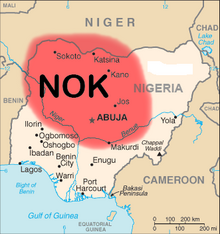Nok culture
 |
|
| Geographical range | West Africa |
|---|---|
| Period | Iron Age |
| Dates | circa 1000 B.C.E. — circa 300 C.E. |
| Type site | Nok |
| Major sites | Samun Dukiya, Taruga, Jos |
| Followed by | Kwararafa |
Coordinates: 9°30′N 8°0′E / 9.500°N 8.000°E
The Nok culture is an early Iron Age population whose material remains are named after the Ham village of Nok in Nigeria, Africa, where their famous terracotta sculptures were first discovered in 1928. The Nok Culture appeared in northern Nigeria around 1000 BCE and vanished under unknown circumstances around 500 CE, thus having lasted for approximately 1,500 years.
Iron use, in smelting and forging for tools, appears in Nok culture by at least 550 BCE and possibly earlier. Data from historical linguistics suggest that iron smelting was independently discovered in the region prior to 1000 BCE. Scientific field work began in 2005 to systematically investigate Nok archaeological sites, and to better understand Nok terracotta sculptures within their Iron Age archaeological context.
The function of Nok terracotta sculptures is still unknown. For the most part, the terracotta is preserved in the form of scattered fragments. That is why Nok art is well known today only for the heads, both male and female, whose hairstyles are particularly detailed and refined. The statues are in fragments because the discoveries are usually made from alluvial mud, in terrain made by the erosion of water. The terracotta statues found there are hidden, rolled, polished, and broken. Rarely are works of great size conserved intact making them highly valued on the international art market.
The terracotta figures are hollow, coil built, nearly life sized human heads and bodies that are depicted with highly stylized features, abundant jewelry, and varied postures.
...
Wikipedia
